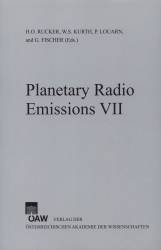
Planetary Radio Emissions VII, pp. 75-86, 2011/12/28
Proceedings of the 7th International Workshop on Planetary, Solar and Heliospheric Radio Emissions held at Graz, Austria, September 15–17, 2010

Earth-orbiting satellites have routinely traversed the source regions of auroral kilometric radiation. This radio emission is generated via the cyclotron maser instability very close to the electron cyclotron frequency. While Cassini’s orbit has crossed auroral field lines, the radial distance at auroral latitudes is typically too high for the analogous Saturn kilometric radiation source. However, on Oct. 17, 2008, the Radio and Plasma Wave Science instrument detected the kilometric radiation at and just below the electron cyclotron frequency. At this time the spacecraft was at a distance of 5 Saturn radii, at 0.9 hours local time, and on L-shells in the range of 25 to above 30. Here the magnetic field suggests the corresponding current was directed upward, away from the planet. Low energy electron observations by the Cassini Plasma Spectrometer instrument suggest that growth of the SKR is likely due to an unstable shell-like distribution.